Comparison of Medical Model and Recovery Model of Mental Illness
VerifiedAdded on 2023/06/06
|8
|2177
|271
AI Summary
This paper compares and contrasts the medical model of mental illness along with the recovery model of mental illness. It highlights the differences between both models on the basis of the experience of the clients who have been experiencing the services of these theories.
Contribute Materials
Your contribution can guide someone’s learning journey. Share your
documents today.
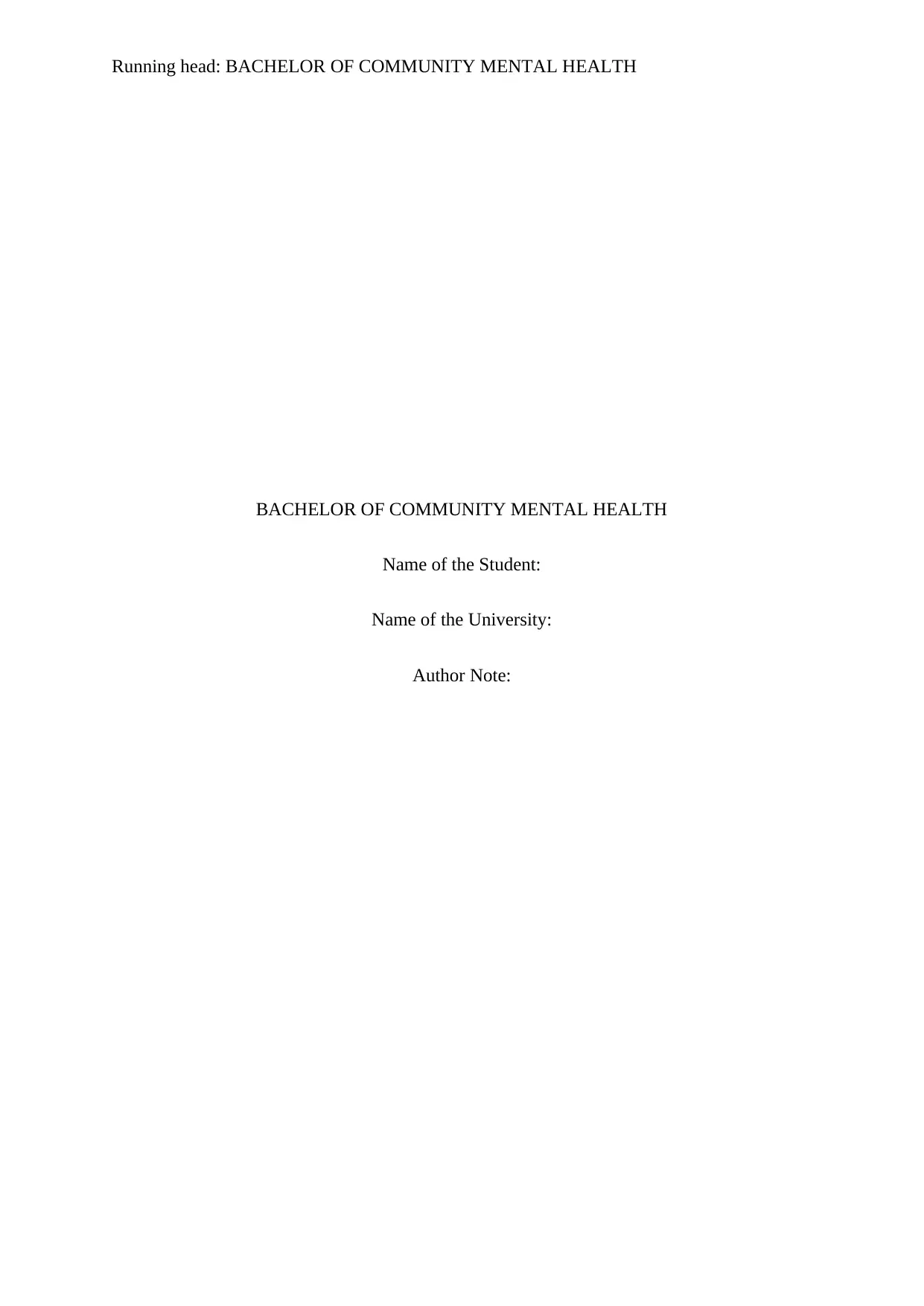
Running head: BACHELOR OF COMMUNITY MENTAL HEALTH
BACHELOR OF COMMUNITY MENTAL HEALTH
Name of the Student:
Name of the University:
Author Note:
BACHELOR OF COMMUNITY MENTAL HEALTH
Name of the Student:
Name of the University:
Author Note:
Secure Best Marks with AI Grader
Need help grading? Try our AI Grader for instant feedback on your assignments.
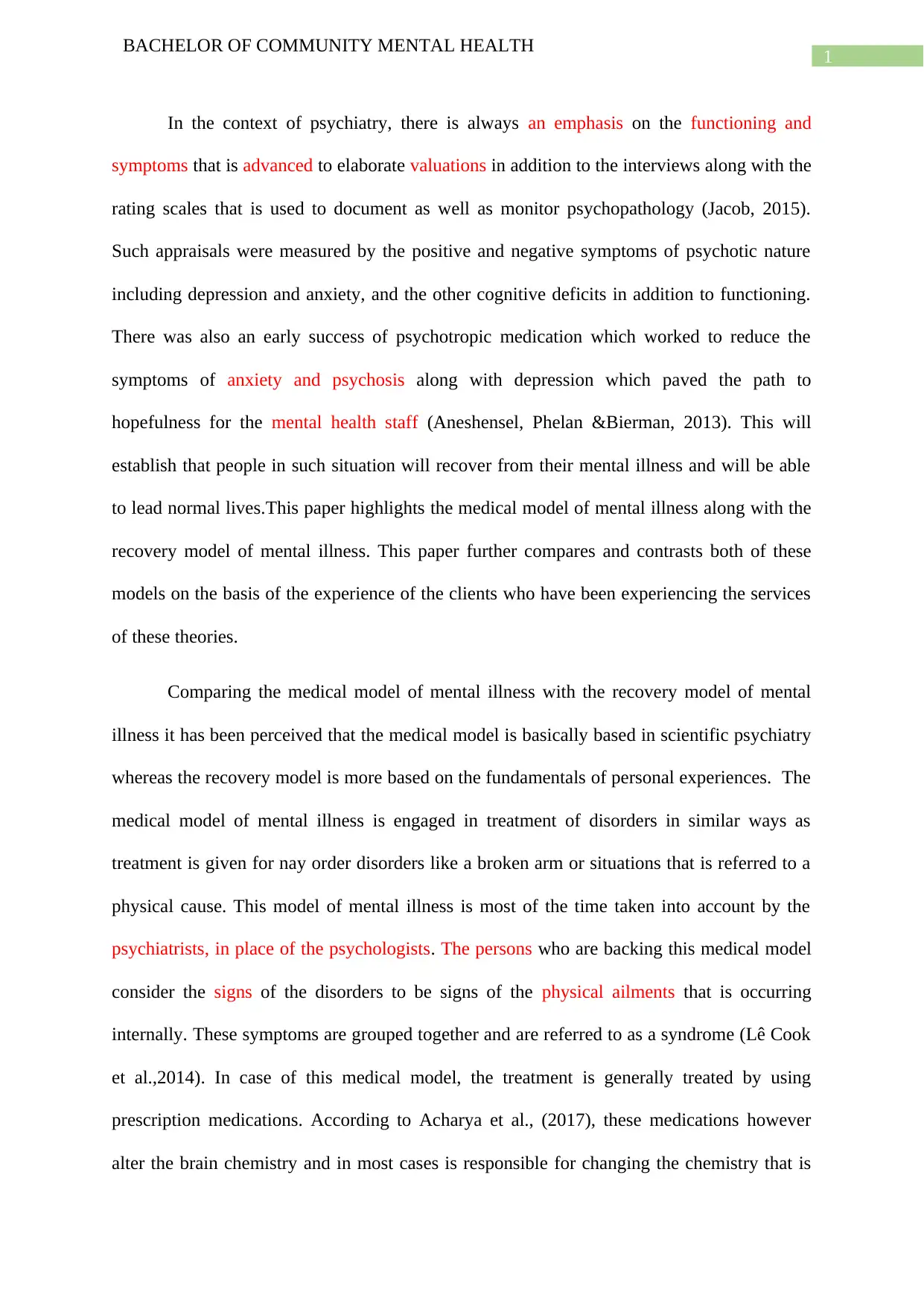
1
BACHELOR OF COMMUNITY MENTAL HEALTH
In the context of psychiatry, there is always an emphasis on the functioning and
symptoms that is advanced to elaborate valuations in addition to the interviews along with the
rating scales that is used to document as well as monitor psychopathology (Jacob, 2015).
Such appraisals were measured by the positive and negative symptoms of psychotic nature
including depression and anxiety, and the other cognitive deficits in addition to functioning.
There was also an early success of psychotropic medication which worked to reduce the
symptoms of anxiety and psychosis along with depression which paved the path to
hopefulness for the mental health staff (Aneshensel, Phelan &Bierman, 2013). This will
establish that people in such situation will recover from their mental illness and will be able
to lead normal lives.This paper highlights the medical model of mental illness along with the
recovery model of mental illness. This paper further compares and contrasts both of these
models on the basis of the experience of the clients who have been experiencing the services
of these theories.
Comparing the medical model of mental illness with the recovery model of mental
illness it has been perceived that the medical model is basically based in scientific psychiatry
whereas the recovery model is more based on the fundamentals of personal experiences. The
medical model of mental illness is engaged in treatment of disorders in similar ways as
treatment is given for nay order disorders like a broken arm or situations that is referred to a
physical cause. This model of mental illness is most of the time taken into account by the
psychiatrists, in place of the psychologists. The persons who are backing this medical model
consider the signs of the disorders to be signs of the physical ailments that is occurring
internally. These symptoms are grouped together and are referred to as a syndrome (Lê Cook
et al.,2014). In case of this medical model, the treatment is generally treated by using
prescription medications. According to Acharya et al., (2017), these medications however
alter the brain chemistry and in most cases is responsible for changing the chemistry that is
BACHELOR OF COMMUNITY MENTAL HEALTH
In the context of psychiatry, there is always an emphasis on the functioning and
symptoms that is advanced to elaborate valuations in addition to the interviews along with the
rating scales that is used to document as well as monitor psychopathology (Jacob, 2015).
Such appraisals were measured by the positive and negative symptoms of psychotic nature
including depression and anxiety, and the other cognitive deficits in addition to functioning.
There was also an early success of psychotropic medication which worked to reduce the
symptoms of anxiety and psychosis along with depression which paved the path to
hopefulness for the mental health staff (Aneshensel, Phelan &Bierman, 2013). This will
establish that people in such situation will recover from their mental illness and will be able
to lead normal lives.This paper highlights the medical model of mental illness along with the
recovery model of mental illness. This paper further compares and contrasts both of these
models on the basis of the experience of the clients who have been experiencing the services
of these theories.
Comparing the medical model of mental illness with the recovery model of mental
illness it has been perceived that the medical model is basically based in scientific psychiatry
whereas the recovery model is more based on the fundamentals of personal experiences. The
medical model of mental illness is engaged in treatment of disorders in similar ways as
treatment is given for nay order disorders like a broken arm or situations that is referred to a
physical cause. This model of mental illness is most of the time taken into account by the
psychiatrists, in place of the psychologists. The persons who are backing this medical model
consider the signs of the disorders to be signs of the physical ailments that is occurring
internally. These symptoms are grouped together and are referred to as a syndrome (Lê Cook
et al.,2014). In case of this medical model, the treatment is generally treated by using
prescription medications. According to Acharya et al., (2017), these medications however
alter the brain chemistry and in most cases is responsible for changing the chemistry that is
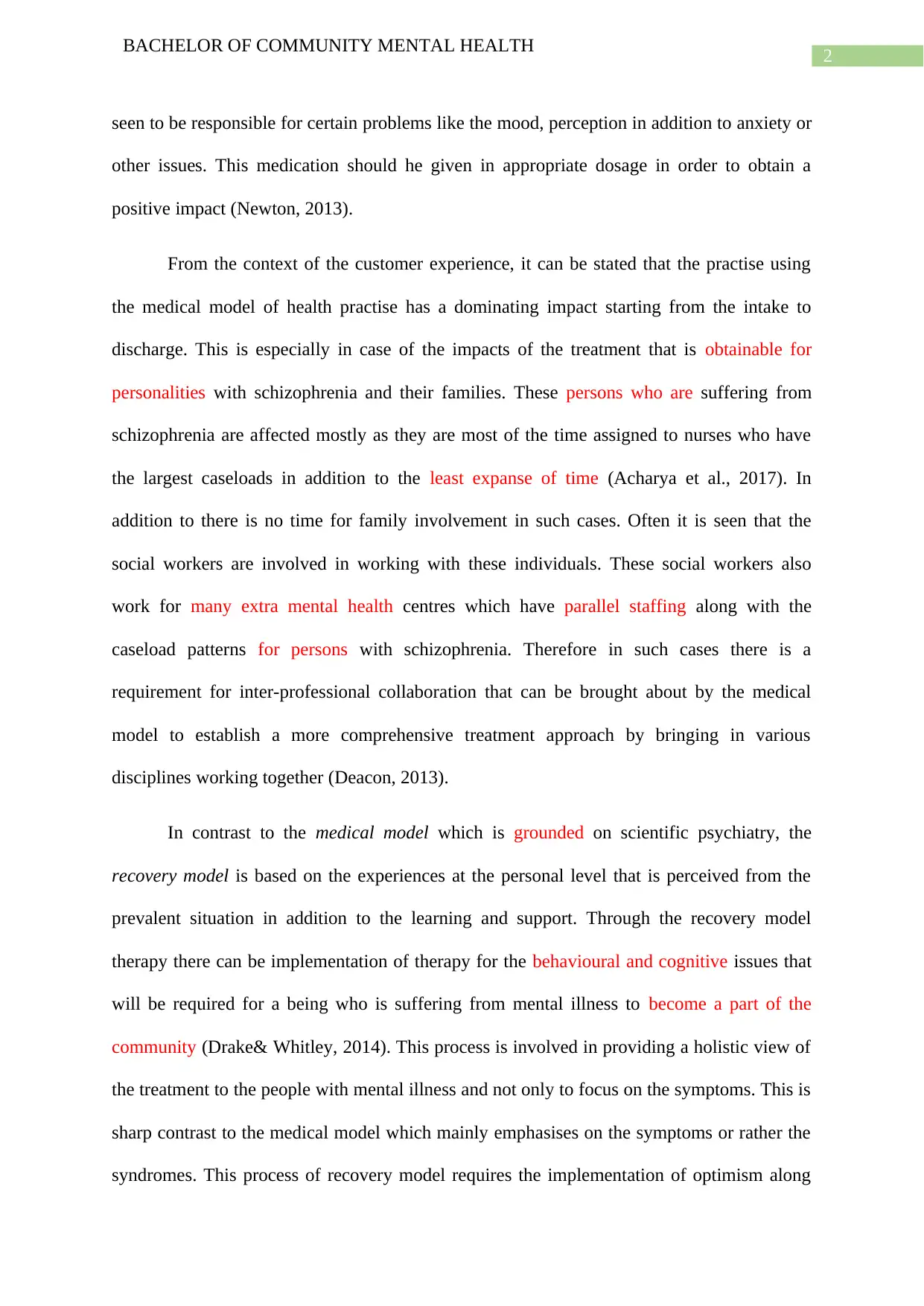
2
BACHELOR OF COMMUNITY MENTAL HEALTH
seen to be responsible for certain problems like the mood, perception in addition to anxiety or
other issues. This medication should he given in appropriate dosage in order to obtain a
positive impact (Newton, 2013).
From the context of the customer experience, it can be stated that the practise using
the medical model of health practise has a dominating impact starting from the intake to
discharge. This is especially in case of the impacts of the treatment that is obtainable for
personalities with schizophrenia and their families. These persons who are suffering from
schizophrenia are affected mostly as they are most of the time assigned to nurses who have
the largest caseloads in addition to the least expanse of time (Acharya et al., 2017). In
addition to there is no time for family involvement in such cases. Often it is seen that the
social workers are involved in working with these individuals. These social workers also
work for many extra mental health centres which have parallel staffing along with the
caseload patterns for persons with schizophrenia. Therefore in such cases there is a
requirement for inter-professional collaboration that can be brought about by the medical
model to establish a more comprehensive treatment approach by bringing in various
disciplines working together (Deacon, 2013).
In contrast to the medical model which is grounded on scientific psychiatry, the
recovery model is based on the experiences at the personal level that is perceived from the
prevalent situation in addition to the learning and support. Through the recovery model
therapy there can be implementation of therapy for the behavioural and cognitive issues that
will be required for a being who is suffering from mental illness to become a part of the
community (Drake& Whitley, 2014). This process is involved in providing a holistic view of
the treatment to the people with mental illness and not only to focus on the symptoms. This is
sharp contrast to the medical model which mainly emphasises on the symptoms or rather the
syndromes. This process of recovery model requires the implementation of optimism along
BACHELOR OF COMMUNITY MENTAL HEALTH
seen to be responsible for certain problems like the mood, perception in addition to anxiety or
other issues. This medication should he given in appropriate dosage in order to obtain a
positive impact (Newton, 2013).
From the context of the customer experience, it can be stated that the practise using
the medical model of health practise has a dominating impact starting from the intake to
discharge. This is especially in case of the impacts of the treatment that is obtainable for
personalities with schizophrenia and their families. These persons who are suffering from
schizophrenia are affected mostly as they are most of the time assigned to nurses who have
the largest caseloads in addition to the least expanse of time (Acharya et al., 2017). In
addition to there is no time for family involvement in such cases. Often it is seen that the
social workers are involved in working with these individuals. These social workers also
work for many extra mental health centres which have parallel staffing along with the
caseload patterns for persons with schizophrenia. Therefore in such cases there is a
requirement for inter-professional collaboration that can be brought about by the medical
model to establish a more comprehensive treatment approach by bringing in various
disciplines working together (Deacon, 2013).
In contrast to the medical model which is grounded on scientific psychiatry, the
recovery model is based on the experiences at the personal level that is perceived from the
prevalent situation in addition to the learning and support. Through the recovery model
therapy there can be implementation of therapy for the behavioural and cognitive issues that
will be required for a being who is suffering from mental illness to become a part of the
community (Drake& Whitley, 2014). This process is involved in providing a holistic view of
the treatment to the people with mental illness and not only to focus on the symptoms. This is
sharp contrast to the medical model which mainly emphasises on the symptoms or rather the
syndromes. This process of recovery model requires the implementation of optimism along
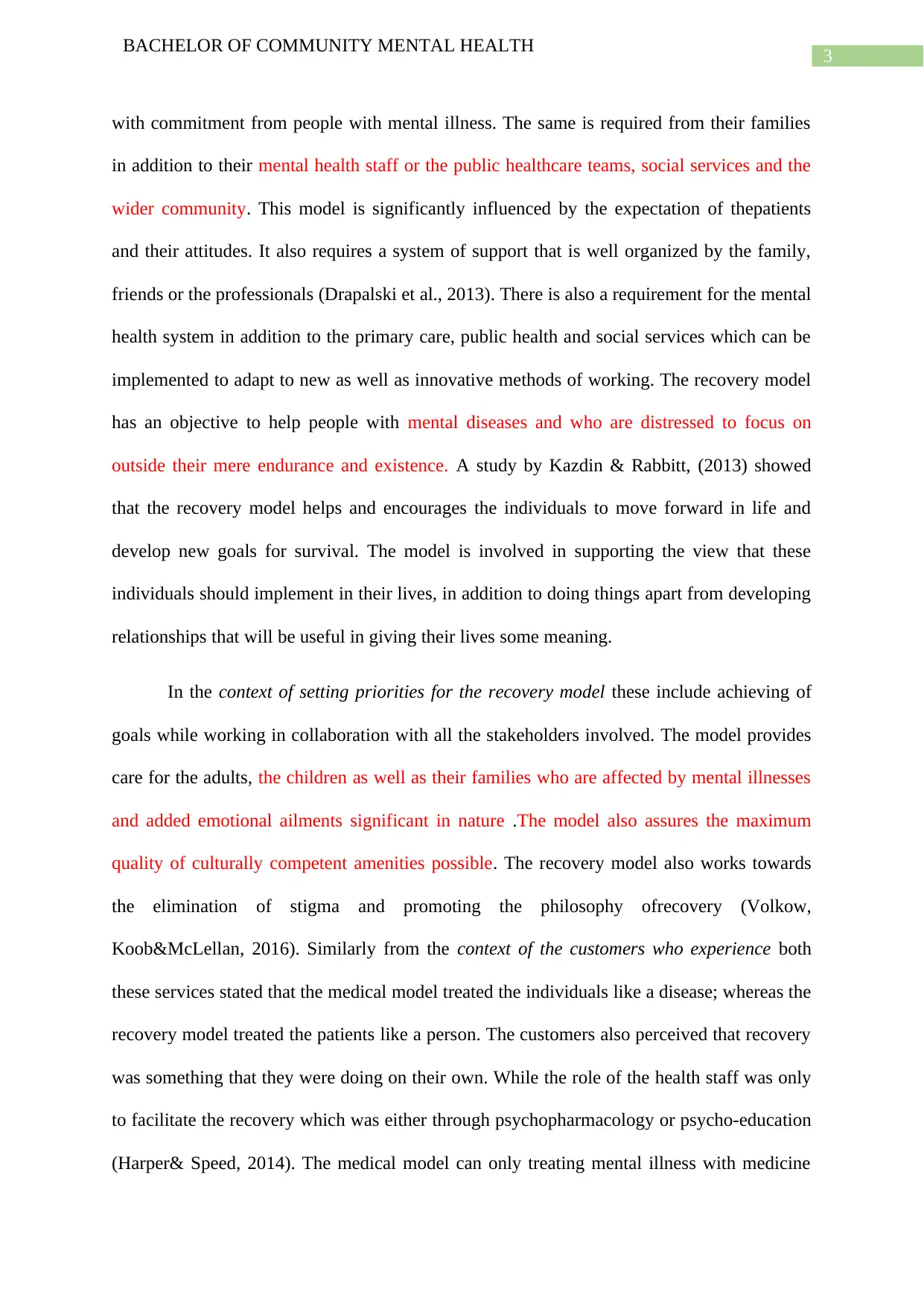
3
BACHELOR OF COMMUNITY MENTAL HEALTH
with commitment from people with mental illness. The same is required from their families
in addition to their mental health staff or the public healthcare teams, social services and the
wider community. This model is significantly influenced by the expectation of thepatients
and their attitudes. It also requires a system of support that is well organized by the family,
friends or the professionals (Drapalski et al., 2013). There is also a requirement for the mental
health system in addition to the primary care, public health and social services which can be
implemented to adapt to new as well as innovative methods of working. The recovery model
has an objective to help people with mental diseases and who are distressed to focus on
outside their mere endurance and existence. A study by Kazdin & Rabbitt, (2013) showed
that the recovery model helps and encourages the individuals to move forward in life and
develop new goals for survival. The model is involved in supporting the view that these
individuals should implement in their lives, in addition to doing things apart from developing
relationships that will be useful in giving their lives some meaning.
In the context of setting priorities for the recovery model these include achieving of
goals while working in collaboration with all the stakeholders involved. The model provides
care for the adults, the children as well as their families who are affected by mental illnesses
and added emotional ailments significant in nature .The model also assures the maximum
quality of culturally competent amenities possible. The recovery model also works towards
the elimination of stigma and promoting the philosophy ofrecovery (Volkow,
Koob&McLellan, 2016). Similarly from the context of the customers who experience both
these services stated that the medical model treated the individuals like a disease; whereas the
recovery model treated the patients like a person. The customers also perceived that recovery
was something that they were doing on their own. While the role of the health staff was only
to facilitate the recovery which was either through psychopharmacology or psycho-education
(Harper& Speed, 2014). The medical model can only treating mental illness with medicine
BACHELOR OF COMMUNITY MENTAL HEALTH
with commitment from people with mental illness. The same is required from their families
in addition to their mental health staff or the public healthcare teams, social services and the
wider community. This model is significantly influenced by the expectation of thepatients
and their attitudes. It also requires a system of support that is well organized by the family,
friends or the professionals (Drapalski et al., 2013). There is also a requirement for the mental
health system in addition to the primary care, public health and social services which can be
implemented to adapt to new as well as innovative methods of working. The recovery model
has an objective to help people with mental diseases and who are distressed to focus on
outside their mere endurance and existence. A study by Kazdin & Rabbitt, (2013) showed
that the recovery model helps and encourages the individuals to move forward in life and
develop new goals for survival. The model is involved in supporting the view that these
individuals should implement in their lives, in addition to doing things apart from developing
relationships that will be useful in giving their lives some meaning.
In the context of setting priorities for the recovery model these include achieving of
goals while working in collaboration with all the stakeholders involved. The model provides
care for the adults, the children as well as their families who are affected by mental illnesses
and added emotional ailments significant in nature .The model also assures the maximum
quality of culturally competent amenities possible. The recovery model also works towards
the elimination of stigma and promoting the philosophy ofrecovery (Volkow,
Koob&McLellan, 2016). Similarly from the context of the customers who experience both
these services stated that the medical model treated the individuals like a disease; whereas the
recovery model treated the patients like a person. The customers also perceived that recovery
was something that they were doing on their own. While the role of the health staff was only
to facilitate the recovery which was either through psychopharmacology or psycho-education
(Harper& Speed, 2014). The medical model can only treating mental illness with medicine
Secure Best Marks with AI Grader
Need help grading? Try our AI Grader for instant feedback on your assignments.
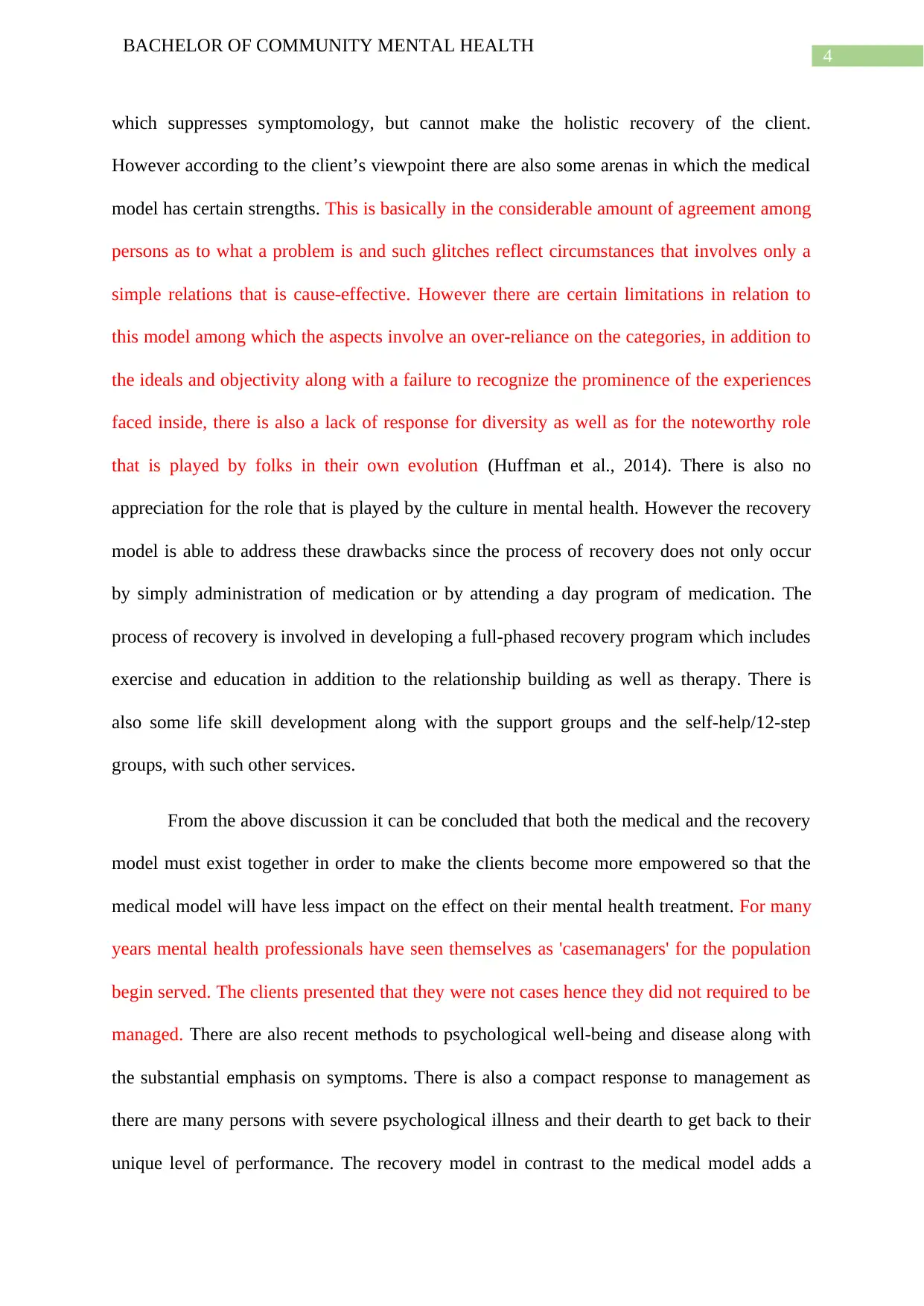
4
BACHELOR OF COMMUNITY MENTAL HEALTH
which suppresses symptomology, but cannot make the holistic recovery of the client.
However according to the client’s viewpoint there are also some arenas in which the medical
model has certain strengths. This is basically in the considerable amount of agreement among
persons as to what a problem is and such glitches reflect circumstances that involves only a
simple relations that is cause-effective. However there are certain limitations in relation to
this model among which the aspects involve an over-reliance on the categories, in addition to
the ideals and objectivity along with a failure to recognize the prominence of the experiences
faced inside, there is also a lack of response for diversity as well as for the noteworthy role
that is played by folks in their own evolution (Huffman et al., 2014). There is also no
appreciation for the role that is played by the culture in mental health. However the recovery
model is able to address these drawbacks since the process of recovery does not only occur
by simply administration of medication or by attending a day program of medication. The
process of recovery is involved in developing a full-phased recovery program which includes
exercise and education in addition to the relationship building as well as therapy. There is
also some life skill development along with the support groups and the self-help/12-step
groups, with such other services.
From the above discussion it can be concluded that both the medical and the recovery
model must exist together in order to make the clients become more empowered so that the
medical model will have less impact on the effect on their mental health treatment. For many
years mental health professionals have seen themselves as 'casemanagers' for the population
begin served. The clients presented that they were not cases hence they did not required to be
managed. There are also recent methods to psychological well-being and disease along with
the substantial emphasis on symptoms. There is also a compact response to management as
there are many persons with severe psychological illness and their dearth to get back to their
unique level of performance. The recovery model in contrast to the medical model adds a
BACHELOR OF COMMUNITY MENTAL HEALTH
which suppresses symptomology, but cannot make the holistic recovery of the client.
However according to the client’s viewpoint there are also some arenas in which the medical
model has certain strengths. This is basically in the considerable amount of agreement among
persons as to what a problem is and such glitches reflect circumstances that involves only a
simple relations that is cause-effective. However there are certain limitations in relation to
this model among which the aspects involve an over-reliance on the categories, in addition to
the ideals and objectivity along with a failure to recognize the prominence of the experiences
faced inside, there is also a lack of response for diversity as well as for the noteworthy role
that is played by folks in their own evolution (Huffman et al., 2014). There is also no
appreciation for the role that is played by the culture in mental health. However the recovery
model is able to address these drawbacks since the process of recovery does not only occur
by simply administration of medication or by attending a day program of medication. The
process of recovery is involved in developing a full-phased recovery program which includes
exercise and education in addition to the relationship building as well as therapy. There is
also some life skill development along with the support groups and the self-help/12-step
groups, with such other services.
From the above discussion it can be concluded that both the medical and the recovery
model must exist together in order to make the clients become more empowered so that the
medical model will have less impact on the effect on their mental health treatment. For many
years mental health professionals have seen themselves as 'casemanagers' for the population
begin served. The clients presented that they were not cases hence they did not required to be
managed. There are also recent methods to psychological well-being and disease along with
the substantial emphasis on symptoms. There is also a compact response to management as
there are many persons with severe psychological illness and their dearth to get back to their
unique level of performance. The recovery model in contrast to the medical model adds a
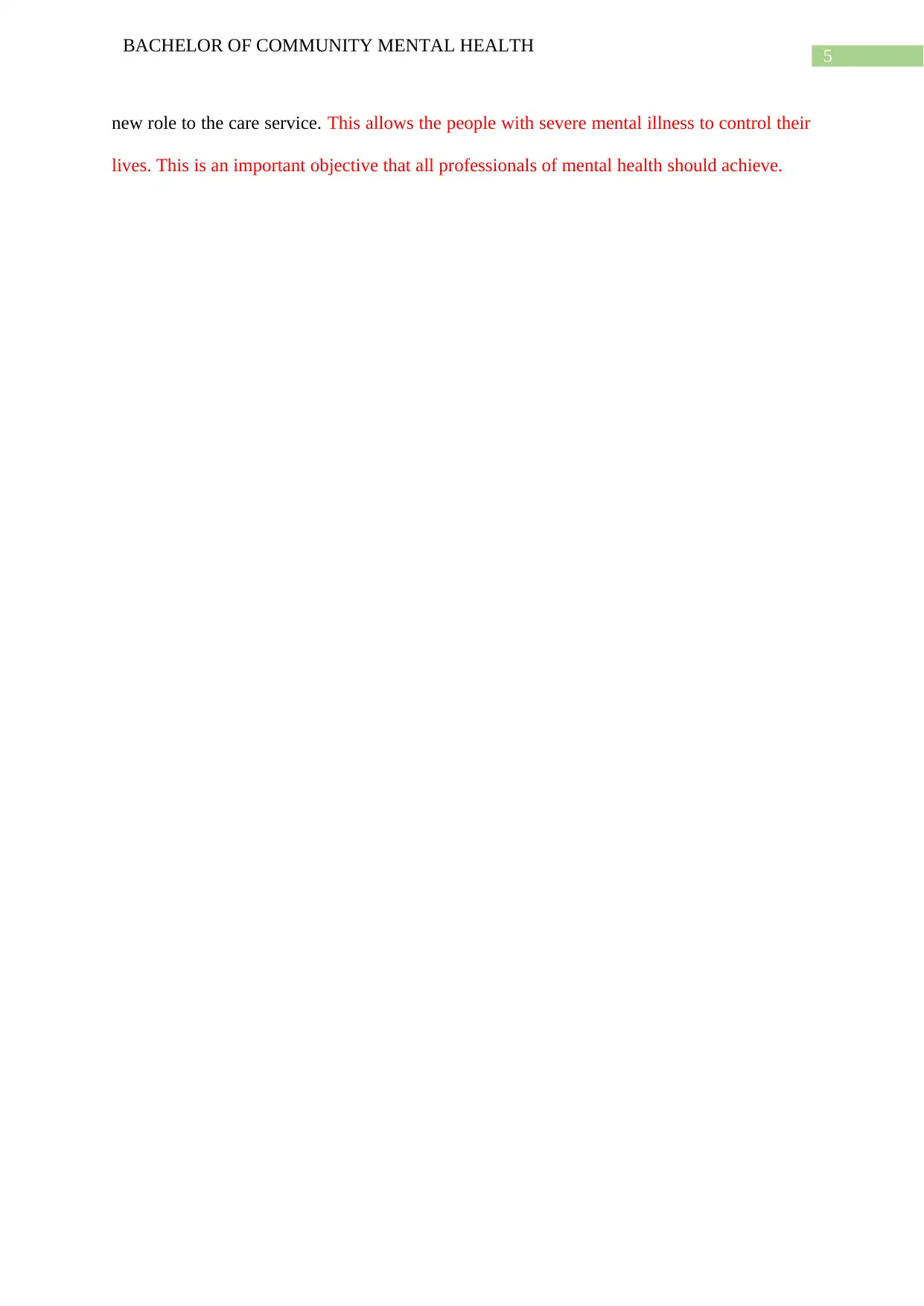
5
BACHELOR OF COMMUNITY MENTAL HEALTH
new role to the care service. This allows the people with severe mental illness to control their
lives. This is an important objective that all professionals of mental health should achieve.
BACHELOR OF COMMUNITY MENTAL HEALTH
new role to the care service. This allows the people with severe mental illness to control their
lives. This is an important objective that all professionals of mental health should achieve.
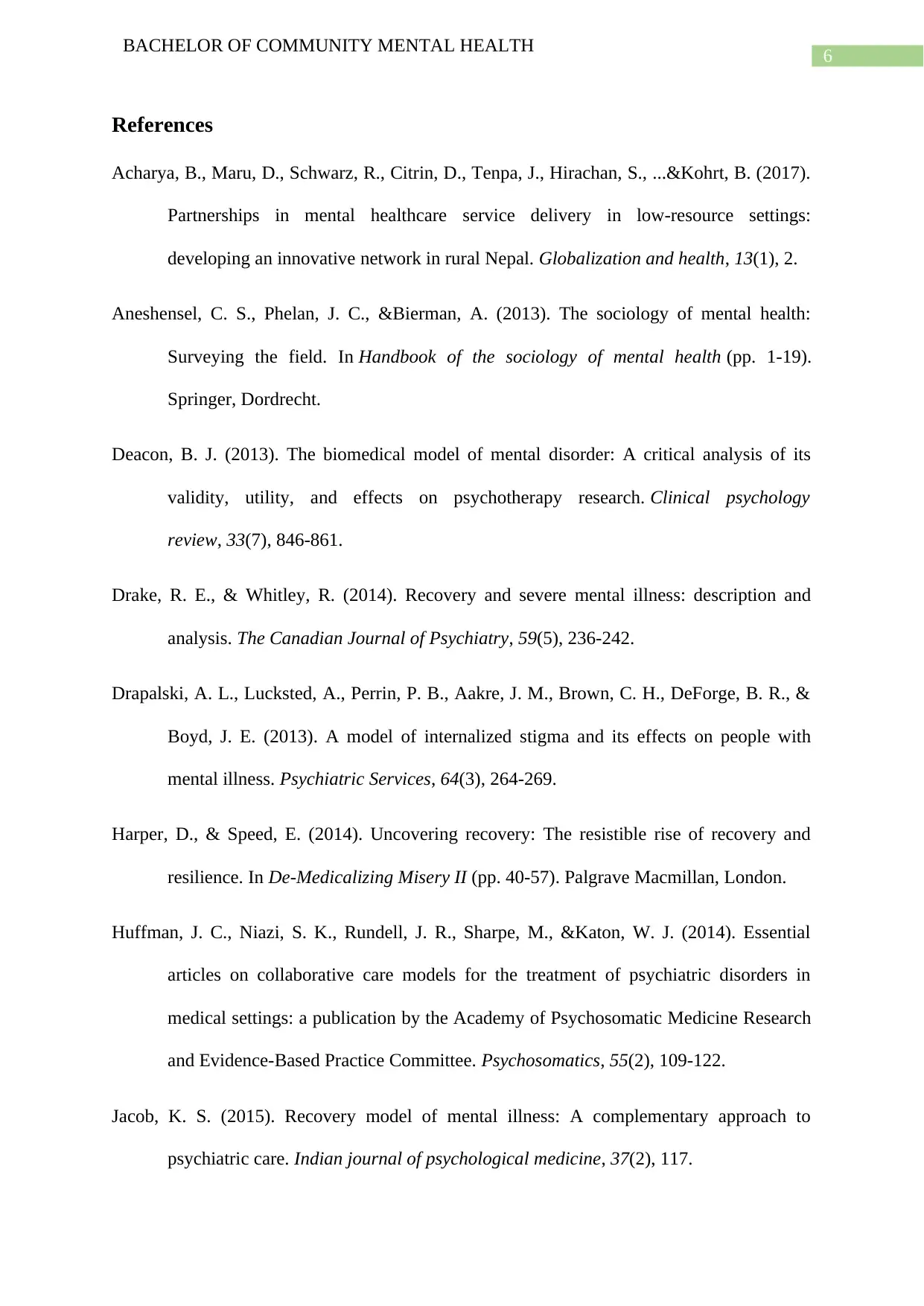
6
BACHELOR OF COMMUNITY MENTAL HEALTH
References
Acharya, B., Maru, D., Schwarz, R., Citrin, D., Tenpa, J., Hirachan, S., ...&Kohrt, B. (2017).
Partnerships in mental healthcare service delivery in low-resource settings:
developing an innovative network in rural Nepal. Globalization and health, 13(1), 2.
Aneshensel, C. S., Phelan, J. C., &Bierman, A. (2013). The sociology of mental health:
Surveying the field. In Handbook of the sociology of mental health (pp. 1-19).
Springer, Dordrecht.
Deacon, B. J. (2013). The biomedical model of mental disorder: A critical analysis of its
validity, utility, and effects on psychotherapy research. Clinical psychology
review, 33(7), 846-861.
Drake, R. E., & Whitley, R. (2014). Recovery and severe mental illness: description and
analysis. The Canadian Journal of Psychiatry, 59(5), 236-242.
Drapalski, A. L., Lucksted, A., Perrin, P. B., Aakre, J. M., Brown, C. H., DeForge, B. R., &
Boyd, J. E. (2013). A model of internalized stigma and its effects on people with
mental illness. Psychiatric Services, 64(3), 264-269.
Harper, D., & Speed, E. (2014). Uncovering recovery: The resistible rise of recovery and
resilience. In De-Medicalizing Misery II (pp. 40-57). Palgrave Macmillan, London.
Huffman, J. C., Niazi, S. K., Rundell, J. R., Sharpe, M., &Katon, W. J. (2014). Essential
articles on collaborative care models for the treatment of psychiatric disorders in
medical settings: a publication by the Academy of Psychosomatic Medicine Research
and Evidence-Based Practice Committee. Psychosomatics, 55(2), 109-122.
Jacob, K. S. (2015). Recovery model of mental illness: A complementary approach to
psychiatric care. Indian journal of psychological medicine, 37(2), 117.
BACHELOR OF COMMUNITY MENTAL HEALTH
References
Acharya, B., Maru, D., Schwarz, R., Citrin, D., Tenpa, J., Hirachan, S., ...&Kohrt, B. (2017).
Partnerships in mental healthcare service delivery in low-resource settings:
developing an innovative network in rural Nepal. Globalization and health, 13(1), 2.
Aneshensel, C. S., Phelan, J. C., &Bierman, A. (2013). The sociology of mental health:
Surveying the field. In Handbook of the sociology of mental health (pp. 1-19).
Springer, Dordrecht.
Deacon, B. J. (2013). The biomedical model of mental disorder: A critical analysis of its
validity, utility, and effects on psychotherapy research. Clinical psychology
review, 33(7), 846-861.
Drake, R. E., & Whitley, R. (2014). Recovery and severe mental illness: description and
analysis. The Canadian Journal of Psychiatry, 59(5), 236-242.
Drapalski, A. L., Lucksted, A., Perrin, P. B., Aakre, J. M., Brown, C. H., DeForge, B. R., &
Boyd, J. E. (2013). A model of internalized stigma and its effects on people with
mental illness. Psychiatric Services, 64(3), 264-269.
Harper, D., & Speed, E. (2014). Uncovering recovery: The resistible rise of recovery and
resilience. In De-Medicalizing Misery II (pp. 40-57). Palgrave Macmillan, London.
Huffman, J. C., Niazi, S. K., Rundell, J. R., Sharpe, M., &Katon, W. J. (2014). Essential
articles on collaborative care models for the treatment of psychiatric disorders in
medical settings: a publication by the Academy of Psychosomatic Medicine Research
and Evidence-Based Practice Committee. Psychosomatics, 55(2), 109-122.
Jacob, K. S. (2015). Recovery model of mental illness: A complementary approach to
psychiatric care. Indian journal of psychological medicine, 37(2), 117.
Paraphrase This Document
Need a fresh take? Get an instant paraphrase of this document with our AI Paraphraser
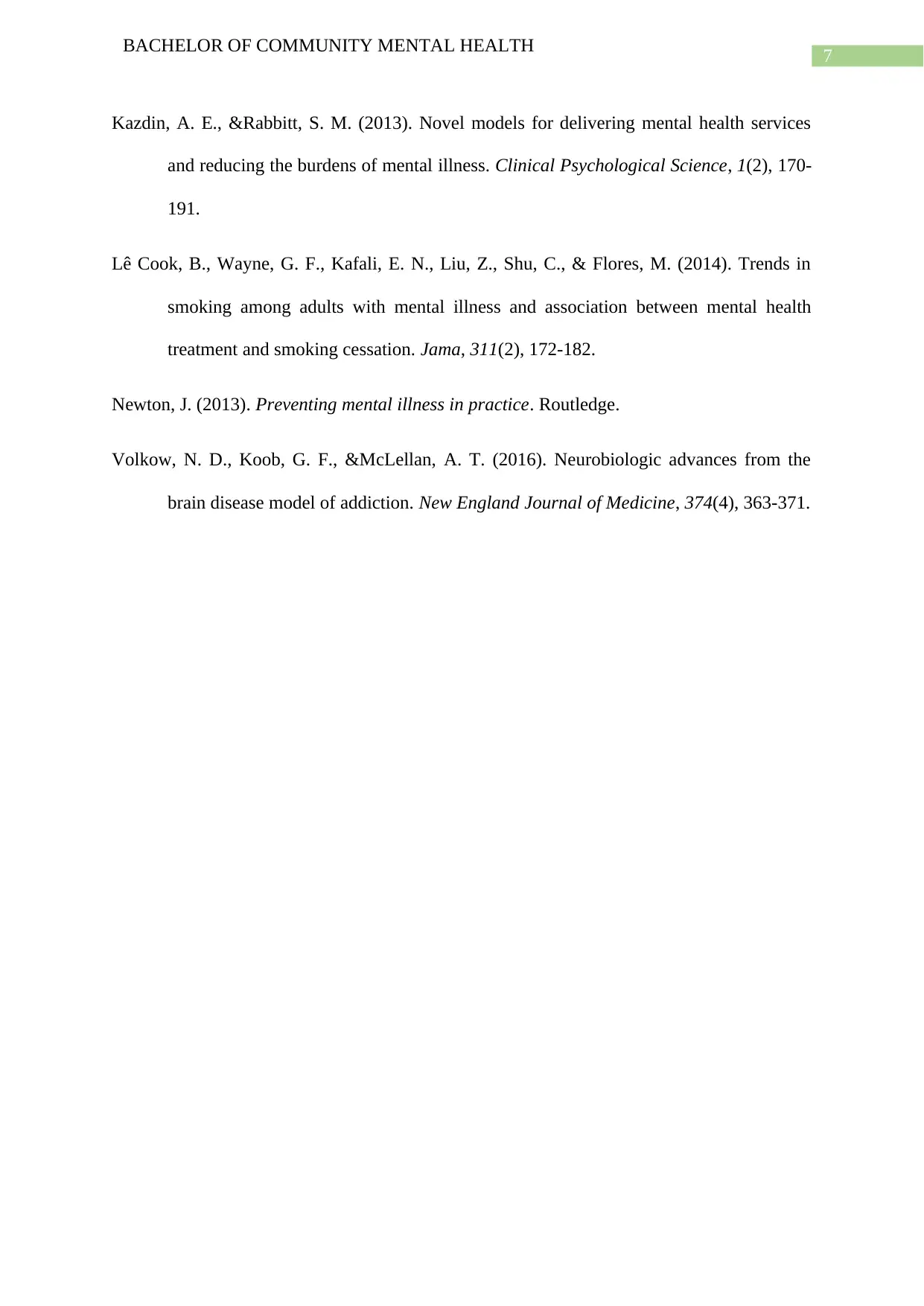
7
BACHELOR OF COMMUNITY MENTAL HEALTH
Kazdin, A. E., &Rabbitt, S. M. (2013). Novel models for delivering mental health services
and reducing the burdens of mental illness. Clinical Psychological Science, 1(2), 170-
191.
Lê Cook, B., Wayne, G. F., Kafali, E. N., Liu, Z., Shu, C., & Flores, M. (2014). Trends in
smoking among adults with mental illness and association between mental health
treatment and smoking cessation. Jama, 311(2), 172-182.
Newton, J. (2013). Preventing mental illness in practice. Routledge.
Volkow, N. D., Koob, G. F., &McLellan, A. T. (2016). Neurobiologic advances from the
brain disease model of addiction. New England Journal of Medicine, 374(4), 363-371.
BACHELOR OF COMMUNITY MENTAL HEALTH
Kazdin, A. E., &Rabbitt, S. M. (2013). Novel models for delivering mental health services
and reducing the burdens of mental illness. Clinical Psychological Science, 1(2), 170-
191.
Lê Cook, B., Wayne, G. F., Kafali, E. N., Liu, Z., Shu, C., & Flores, M. (2014). Trends in
smoking among adults with mental illness and association between mental health
treatment and smoking cessation. Jama, 311(2), 172-182.
Newton, J. (2013). Preventing mental illness in practice. Routledge.
Volkow, N. D., Koob, G. F., &McLellan, A. T. (2016). Neurobiologic advances from the
brain disease model of addiction. New England Journal of Medicine, 374(4), 363-371.
1 out of 8
Related Documents
Your All-in-One AI-Powered Toolkit for Academic Success.
+13062052269
info@desklib.com
Available 24*7 on WhatsApp / Email
![[object Object]](/_next/static/media/star-bottom.7253800d.svg)
Unlock your academic potential
© 2024 | Zucol Services PVT LTD | All rights reserved.




